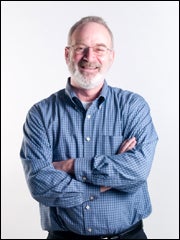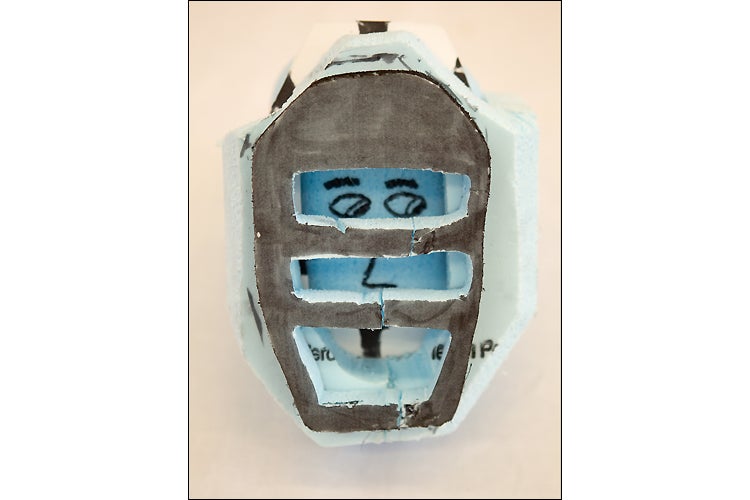‘Up by the bootstraps’: developing creative young minds at ECU’s Innovators Academy
Building a shiny new factory in a small, quiet community: that’s how most people envision economic development, said Wayne Godwin, director of East Carolina University’s Innovation Design Lab.
But that’s not the only way it happens. There’s another approach and it’s called “pulling yourself up by the bootstraps,” Godwin said. There’s been some bootstrap-pulling going on at East Carolina University this month, during the Middle School Innovators Academy, a two-week program for Pitt County 6th graders. Nine academy graduates presented ideas for innovative projects at a ceremony on campus June 23.
The Middle School Innovators Academy helps the region by taking advantage of “the bright and creative minds right here in the neighborhood,” Godwin said. Those creative minds are students from Pitt County’s Hope Middle School.
Students were paired with ECU faculty, middle school teachers and ECU School of Art undergraduates concentrating in animation and interactive design. With expert guidance, the middle schoolers learned to generate creative ideas and mold those ideas into reality using the state-of-the-art equipment at ECU’s Innovation Design Lab.

Wayne Godwin
(Contributed photo)
Hope Middle School art teacher Debbie Huggins worked with the students. “This program is great,” she said. “It’s taking all those 21st century skills that we are begging for and helping the students apply them. The students discover concrete ways of channeling their creative thought processes from idea to fact.”
Huggins said the students are naturally creative, but they need guidance to show how to put their ideas into action. In the academy, she said, the students have access to both the guidance and the technology to make their ideas come alive.
The students’ ideas ranged from baby bottles to devices that protect garbage cans from predators. Each product included unique features that extended beyond products already available on the market.
James Darden created the Guru, a cleaning robot for public spaces that collects discarded recyclable materials with a rotating claw, then vacuums and mops the area left behind. His robot identifies recyclables by the presence of UPC labels. Thermal sensors prevent the robot from grasping small animals or humans.
Creating the Guru concept in the academy was “lots of fun,” Darden said. “We learned different ways of thinking up new ideas and how to make them work. People sat down with us and showed us how to take our ideas and make them real.”
Academy graduate Hannah Sargent devised the Recycle Ball, a recyclable container outfitted with a basketball goal to raise awareness and encourage recycling. She thoroughly enjoyed the camp and was “excited to receive the invitation,” parents William and Bonnie Sargent said.
Other ideas included an inexpensive cold-gel catcher’s mitt to prevent heat exhaustion during baseball games, an insulated double-sided baby bottle that keeps two separate liquids hot or cold, and a high capacity automated pet feeder that uses an RFID tracking system so only a tagged pet can receive food.
The Innovators Academy is a collaboration between ECU and the College of Design at North Carolina State University. Godwin worked with Percy Hooper, director of NCSU’s industrial design graduate program, to develop the program. A parallel summer academy takes place at the Centennial Campus Middle School in Raleigh.
Hooper said the academy addresses the question, “What can we do as a higher education institution to infuse innovation into our public school system?” He said the program targeted 6th graders because research indicates that by 7th or 8th grade, students have already decided whether they will finish school or not.
“This program gives them an exciting reason to stay in school,” he said.
The ECU program is housed within the Office of Engagement, Innovation and Economic Development, directed by associate vice chancellor Ted Morris. Morris said that it is important for universities to take a role in preparing a skilled work force for the region and the state.
Statistics show that out of every 10 high school graduates, three are actively recruited by universities, industry or armed forces, according to Morris. “We want to help make those three as impactful as possible and also help the other seven,” he said.
One of those seven might be an innovative thinker, Morris said, because the potential for creative thought is not always readily apparent in children’s grades or school performance. The academy selects students identified as having potential for innovative thinking, regardless of grades.
This summer marks the academy’s second year and plans for expansion are next on the agenda. Godwin noted that approximately 400,000 people live in a 30-mile radius around Greenville. Since it’s rural, he said, there’s not a public transportation system that could bring students from those areas in to attend the academy.
A new distance education component is in the works to address that issue, by using social media networks to reach an expanded population. The academy is also sharing information with the military, where there is a strong need for developing new methods for solving problems creatively.
“We want to bring to the entire region a culture of innovation by expanding this program to a larger audience,” Godwin said.
For additional information about the academy, contact Godwin at (252) 328-2358 or godwinw@ecu.edu.
